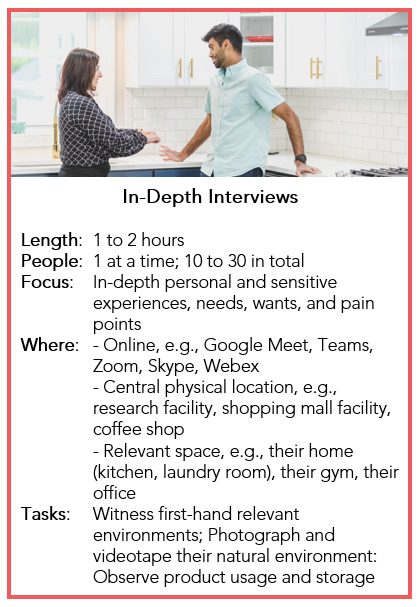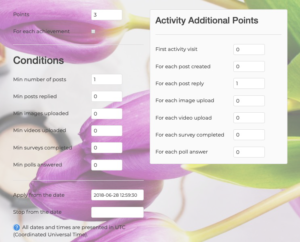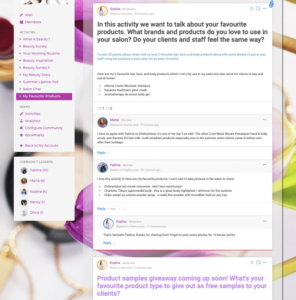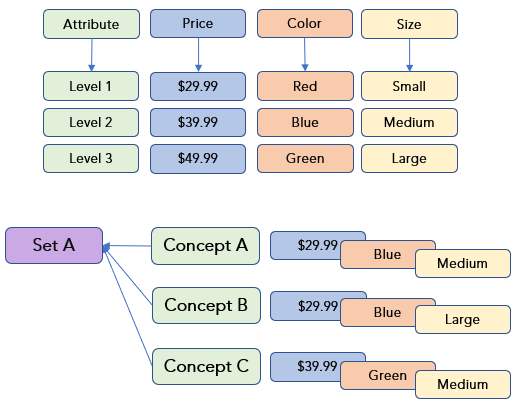
Are you launching a start-up? Then I bet you have hundreds of questions about your potential product and your target audience.
From conceptualization to market sizing and scaling, innumerable questions must be answered in order to build a solid foundation for a successful business. Fortunately, a full range of qualitative and quantitative research, primary and secondary research, and data analytics solutions exist to help you discover actionable answers to those questions throughout the entire process.
During the initial conceptualization stage, you’ll need to gain a comprehensive and unbiased understanding of the problem and potential solutions. You’ll also need to understand the tangents, side-conversations, and unspoken truths and myths that people won’t necessarily share with just anyone. To gain these types of insights from your target audience, qualitative research will be your go-to method.
Numerous qualitative techniques can help you at this point so let’s start by learning about in-depth, individual interviews.
What are individual interviews?
 As the name suggests, individual interviews are in-depth conversations between a trained moderator and one other person. If the product or service is specifically designed for 2 or 3 people to use together, dyads or triads with colleagues, best friends, children, partners, or spouses may be used as well.
As the name suggests, individual interviews are in-depth conversations between a trained moderator and one other person. If the product or service is specifically designed for 2 or 3 people to use together, dyads or triads with colleagues, best friends, children, partners, or spouses may be used as well.
Key to this technique is working with a trained moderator. Although everyone has experience chatting with consumers, customers, or clients on a one to one basis, a research interview is completely different from a “chat” or “conversation.”
Trained moderators have unique skills which include understanding and responding to the body language of the person they’re interviewing. They have learned how and when to use specific language to encourage someone to share more detailed and personal insights. And, most importantly, they actively strive to prevent bias from unconsciously creeping into a conversation.
Interviews are an excellent way to deeply connect with your target audience and get a first-hand look into their emotional and physical real world. Interviews will allow you to:
- Spend meaningful time with them such that they open up about their personal habits, behaviors, needs, drivers, emotions, and opinions.
- Watch and listen to them struggle using unsuitable, existing products and services in their real world, whether that’s in their home, school, office, or gym.
- Watch and listen to them as they attempt to shop for alternative products using both online and offline channels.
These observations will guide you towards a thorough and unbiased understanding of what the problems and required solutions really are.
What follows are key questions that an interviewer might address during the initial, conceptualization stage.
How are people emotionally connected to the problem?
- How do you feel about this situation? What types of emotions do you have dealing with this situation? How strong are those emotions?
- How does this situation interact with different aspects of your life – at home, at work, with your kids or parents?
- How do you feel about the available alternatives or lack of alternatives? How do you compensate for the lack of easily accessible alternatives?
- What is your emotional state when you really need an alternative and can’t find one?
- How do your personal finances and resources fit into finding alternatives?
Who are the primary and secondary stakeholders?
- Who uses or needs the product? Who else might use it if they saw it lying around? Who would do the shopping for it? Who would approve and pay for it? Who would ensure the product gets used? Who would help you use the product and how would they help you use it?
- What frustrations and pain points do you have during the situation? What are the pain points of people who must find alternative options and pay for alternatives for you?
- Who is negatively and positively affected by this situation being unresolved?
What alternative solutions are being used now?
- What compromises do you make regarding this situation?
- What do you wish you could do? How would you solve the situation?
- How do you find and learn about potential alternatives?
- How do you physically manipulate or use current products? What other items do you use the product with? What do you buy to support using the current product?
- Where do you use current and alternative products? How do you use them?
- Where do you store current products and packages? What are your fears about storing them?
What’s Next?
During the conceptualization stage, your main goal is to listen and understand the problem without bias. You need to truly hear people and learn about their personal experiences so that you can identify both major and minor problems that may need to be solved. Individual interviews are the perfect solution for understanding people’s most intimate perceptions and behaviors. You’ll build a broad and deep baseline for what the key problems are and the range of major and minor issues that need to be resolved.
If you’re ready to deeply understand your target audience with individual interviews, please get in touch with us. We’d love to help you grow your start-up into a successful business! Email your questions about gathering information to support your startup to our research experts using Projects at E2Eresearch dot com.
Learn more from our case studies
- Building a Strategic Business Plan Grounded in Industry Data – A pharmaceutical data analytics case study
- Creating a Beverage Launch Strategy in a Competitive Market – A beverage desk research case study
- Developing a New Nutritional Pasta Product – A survey + desk research case study
- Identifying Optimum Price Corridors to Predict Volume Share – An advertising price simulator case study
Podcasts You Might Like
- Masters of Scale with Reid Hoffman
- The Tim Ferriss Show
- Business Wars with David Brown
- How I Built This with Guy Raz
Books You Might Like
- What It Takes: How I Built a $100 Million Business Against the Odds Hardcover by Raegan Moya-Jones
- The Entrepreneur Roller Coaster: It’s Your Turn to #Jointheride Hardcover by Darren Hardy
- What I Wish I Knew When I Was 20 – 10th Anniversary Edition: A Crash Course on Making Your Place in the World by Tina Seelig
Conferences You Might Like
- CES Consumer Technology Association (January)
- AWE (June)
- Collision Conference (June)
- The Startup Conference (May)
- SaaStr Annual (September)


 Like any market or consumer research project that intends to generalize valid and reliable findings to a broader population, every insight community needs clear planning, goals, and research objectives that lead to specific outcomes. “Signing up” or “finding lots of members” are not acceptable goals, nor is “getting lots of comments every day.”
Like any market or consumer research project that intends to generalize valid and reliable findings to a broader population, every insight community needs clear planning, goals, and research objectives that lead to specific outcomes. “Signing up” or “finding lots of members” are not acceptable goals, nor is “getting lots of comments every day.”  From focus groups to questionnaires, researchers have many data collection tools to choose from, each with their own benefits. However, insight communities that allow people to log in and out at their own convenience have many benefits for participants. They:
From focus groups to questionnaires, researchers have many data collection tools to choose from, each with their own benefits. However, insight communities that allow people to log in and out at their own convenience have many benefits for participants. They: Communities aren’t a quick alternative to groups or interviews. Even if a community is planned to run over just a couple of days, it requires extensive pre-planning, moderation during those days, and lots of post-project analysis and identification of next steps. Without planning for this investment of time and resources, everyone’s efforts will be lost.
Communities aren’t a quick alternative to groups or interviews. Even if a community is planned to run over just a couple of days, it requires extensive pre-planning, moderation during those days, and lots of post-project analysis and identification of next steps. Without planning for this investment of time and resources, everyone’s efforts will be lost. Insight communities also have clear rules for participants who wish to join and remain part of the community. They may include requirements to:
Insight communities also have clear rules for participants who wish to join and remain part of the community. They may include requirements to: Insight communities can take many forms. Sometimes, they’re just a few days long and focus on one or two specific products. Other times, they can last several months and focus on broad categories.
Insight communities can take many forms. Sometimes, they’re just a few days long and focus on one or two specific products. Other times, they can last several months and focus on broad categories. Online communities help lower costs in different ways. First, longer-term communities can take the place of multiple ad-hoc projects. This eliminates the need to recruit participants multiple times. Further, participants are already ‘trained’ in how research works and need far less time and guidance to navigate the software and complete the tasks.
Online communities help lower costs in different ways. First, longer-term communities can take the place of multiple ad-hoc projects. This eliminates the need to recruit participants multiple times. Further, participants are already ‘trained’ in how research works and need far less time and guidance to navigate the software and complete the tasks. 


 Include competitors: The real market includes competitors, often many. People don’t shop for single brands in isolation and neither should they answer your conjoint questions in isolation. Include at least one key competitor in your test, and preferably at least two. Further, if your brand is relatively unknown, you may wish to incorporate a competitor that is also relatively unknown.
Include competitors: The real market includes competitors, often many. People don’t shop for single brands in isolation and neither should they answer your conjoint questions in isolation. Include at least one key competitor in your test, and preferably at least two. Further, if your brand is relatively unknown, you may wish to incorporate a competitor that is also relatively unknown. Use imagery: We already know that a conjoint task can be cognitively demanding. That’s why imagery helps. Not only does it help people to visualize the product on the shelf amongst it’s competitive brands, it also helps to create a more visually appealing task (mmmmm cookies!). If you can’t provide an image of your product, find other ways to incorporate visuals in the questionnaire.
Use imagery: We already know that a conjoint task can be cognitively demanding. That’s why imagery helps. Not only does it help people to visualize the product on the shelf amongst it’s competitive brands, it also helps to create a more visually appealing task (mmmmm cookies!). If you can’t provide an image of your product, find other ways to incorporate visuals in the questionnaire.